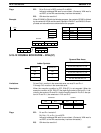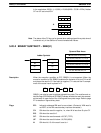
239
Example The following example shows how to divide two whole four-digit numbers (i.e.,
numbers without fractions) so that a floating-point value can be obtained.
First the original numbers must be placed in floating-point form. Because the
numbers are originally without decimal points, the exponent will be 4 (e.g., 3452
would equal 0.3452 x 10
4
). All of the moves are to place the proper data into con-
secutive words for the final division, including the exponent and zeros. Data
movements for Dd and Dd+1 are shown at the right below. Movements for Dr
and Dr+1 are basically the same. The original values to be divided are in DM
0000 and DM 0001. The final division is also shown.
BCD Calculations Section 5-19


















